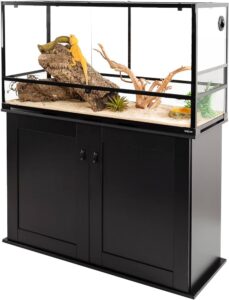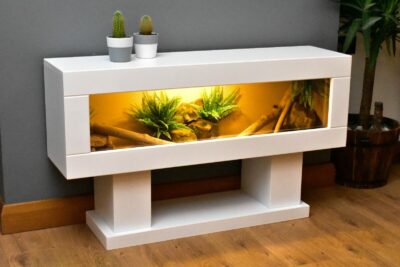Are you a reptile lover looking to elevate your pet’s habitat? Look no further than the Reptile Cage Stand! This essential accessory not only adds a touch of style to your reptile enclosure but also provides practical benefits.
With a reptile cage stand, you can easily position your pet’s home at the perfect viewing height, making it easier for you to interact with and observe your scaly friends. Plus, these stands offer stability and security, ensuring your reptile’s environment remains safe and secure.
Whether you’re a beginner or a seasoned reptile enthusiast, a reptile cage stand is a must-have addition to your setup. So why wait? Elevate your reptile’s home today with a Reptile Cage Stand!
Importance of a reptile cage stand in maintaining a healthy habitat

A reptile cage stand plays a crucial role in maintaining a healthy habitat for your reptile friend. Here’s why:
- Stability and Security: A sturdy stand provides stability for the reptile enclosure, preventing accidental tipping or shaking that could stress out your reptile or even injure them.
- Proper Ventilation: Elevating the enclosure off the ground ensures adequate airflow around the cage, which is essential for maintaining proper humidity levels and preventing the buildup of stale air or mold.
- Temperature Regulation: Placing the enclosure on a stand helps regulate temperature more effectively. Heat rises, so having the enclosure elevated ensures that the warmer air circulates properly, creating a gradient from warmer at the top to cooler at the bottom, mimicking the natural environment of many reptiles.
- Accessibility for Maintenance: A stand raises the cage to a comfortable height for maintenance tasks such as cleaning, feeding, and observing your reptile. This makes it easier for you to care for your pet and reduces the likelihood of strain or injury from bending or reaching.
- Protection from Predators and Other Hazards: Keeping the enclosure elevated can help protect your reptile from potential threats like other pets or small children. It also reduces the risk of accidental spills or damage from household activities.
- Aesthetic Considerations: A well-designed stand can enhance the overall appearance of your reptile habitat, creating a more attractive and cohesive display in your home or office.
Types of Reptile Cage Stands
There are several types of reptile cage stands available, each offering different features and benefits. Here are some common types:
- Metal Stands: Metal stands are durable and sturdy, capable of supporting heavy reptile enclosures. They often have adjustable feet to accommodate uneven floors and come in various finishes to match different decor styles.
- Wooden Stands: Wooden stands are popular for their natural look and ability to blend in with furniture. They are typically strong and sturdy, but it’s essential to ensure the wood is properly sealed to resist moisture and prevent warping or rot.
- PVC Stands: PVC stands are lightweight, easy to clean, and resistant to moisture, making them ideal for humid reptile environments. They come in various colors and designs and are often customizable to fit specific enclosure sizes.
- DIY Stands: Some reptile keepers prefer to build their own stands using materials like wood, PVC, or metal. DIY stands allow for customization to fit unique enclosure dimensions and can be a cost-effective option for those with woodworking or metalworking skills.
- Stackable Racks: Stackable racks are designed to hold multiple reptile enclosures vertically, maximizing space efficiency in reptile breeding or display setups. They are typically made of metal or PVC and come with shelves or platforms to support each enclosure securely.
- Cabinet Stands: Cabinet stands combine the functionality of a reptile enclosure stand with additional storage space for supplies, food, and accessories. They often feature doors or drawers for easy access and can help keep your reptile area organized and clutter-free.
When choosing a reptile cage stand, consider factors such as the weight and size of your enclosure, the material’s durability and resistance to moisture, and any additional features you may need, such as storage space or adjustable height.
Factors to Consider When Choosing a Reptile Cage Stand
When selecting a reptile cage stand, it’s essential to consider several factors to ensure it meets your needs and provides a suitable environment for your reptile. Here are some key considerations:
- Size and Weight Capacity: Ensure that the stand is strong enough to support the weight of your reptile enclosure, including any additional accessories or decorations. Consider the dimensions of both the stand and the enclosure to ensure a proper fit.
- Material and Durability: Choose a stand made from durable materials that can withstand the humidity and wear and tear associated with reptile habitats. Common materials include metal, wood, and PVC. Ensure that the material is resistant to moisture, corrosion, and warping.
- Ventilation and Airflow: Opt for a stand that allows for adequate airflow around the enclosure to maintain proper ventilation and humidity levels. Look for designs that incorporate open shelving or slatted surfaces to promote air circulation.
- Stability and Security: Select a stand that provides stability and prevents tipping or wobbling, especially if you have a large or heavy enclosure. Look for features such as adjustable leveling feet or floor anchors to ensure a secure fit on uneven surfaces.
- Accessibility and Maintenance: Consider how easy it will be to access the enclosure for cleaning, feeding, and maintenance tasks. Choose a stand that elevates the enclosure to a comfortable height and provides convenient access to all sides.
- Aesthetic Appeal: Take into account the appearance of the stand and how well it complements your home or office decor. Choose a style and finish that aligns with your preferences and creates a cohesive look with the rest of your furniture and surroundings.
- Additional Features: Look for any additional features or accessories that may enhance the functionality of the stand, such as built-in storage shelves or cabinets, cable management systems, or integrated lighting options.
- Budget: Consider your budget and choose a stand that offers the best balance of quality, features, and affordability within your price range. Compare prices and features from different brands and retailers to find the best value for your money.
By considering these factors carefully, you can choose a reptile cage stand that provides a stable, secure, and comfortable habitat for your reptile friend while also meeting your practical and aesthetic preferences.
Benefits of Using a Reptile Cage Stand

Using a reptile cage stand offers several benefits for both you and your reptile friend:
- Stability and Security: Elevating the reptile enclosure on a stand provides a stable and secure base, reducing the risk of accidental tipping or shaking. This stability ensures the safety of your reptile and prevents injuries or stress.
- Improved Ventilation: Elevating the enclosure allows for better airflow around the cage, promoting proper ventilation and preventing the buildup of stale air or humidity. This helps maintain a healthy environment for your reptile by reducing the risk of respiratory problems and mold growth.
- Temperature Regulation: Placing the enclosure on a stand helps regulate temperature more effectively. Heat rises, so elevating the enclosure ensures that warmer air circulates properly, creating a gradient from warmer at the top to cooler at the bottom. This mimics the natural thermal gradient found in many reptile habitats and promotes thermoregulation.
- Accessibility for Maintenance: A stand raises the cage to a comfortable height for maintenance tasks such as cleaning, feeding, and observation. This makes it easier for you to care for your reptile and reduces the strain on your back from bending or reaching.
- Protection from Hazards: Keeping the enclosure elevated can help protect your reptile from potential hazards such as other pets, small children, or accidental spills. This provides a safer environment for your reptile and reduces the risk of injury or stress.
- Aesthetic Appeal: A well-designed stand can enhance the overall appearance of your reptile habitat, creating a more attractive and cohesive display in your home or office. Stands come in various styles, finishes, and materials to complement your decor and personal preferences.
- Space Optimization: Using a stand allows you to make the most efficient use of space in your home or reptile room. By elevating the enclosure off the floor, you free up valuable floor space for other furniture or activities.
Overall, using a reptile cage stand provides numerous benefits that contribute to the health, safety, and well-being of your reptile, as well as enhancing the aesthetics and functionality of their habitat.
Tips for Setting Up and Using a Reptile Cage Stand
Setting up and using a reptile cage stand involves several steps to ensure a safe and comfortable environment for your reptile friend. Here are some tips to help you:
- Choose the Right Size: Select a stand that is appropriately sized to accommodate your reptile enclosure. Ensure that the stand is strong enough to support the weight of the enclosure and any additional accessories.
- Assemble the Stand: Follow the manufacturer’s instructions carefully to assemble the stand correctly. Make sure all components are securely fastened and stable before placing the reptile enclosure on top.
- Level the Stand: Use a level to ensure that the stand is perfectly level on the floor. Adjust the leveling feet or add shims as needed to achieve stability and prevent wobbling.
- Position the Stand: Place the stand in a suitable location within your home or reptile room. Ensure that there is adequate space around the stand for easy access and maintenance.
- Install the Reptile Enclosure: Carefully place the reptile enclosure on top of the stand, ensuring that it is centered and secure. Check that the enclosure is level and stable before adding any substrate or decorations.
- Provide Proper Ventilation: Ensure that there is adequate airflow around the reptile enclosure to maintain proper ventilation and humidity levels. Avoid placing the enclosure in a drafty area or blocking air vents.
- Regulate Temperature: Monitor the temperature inside the reptile enclosure to ensure that it remains within the appropriate range for your reptile species. Use heat lamps, heat mats, or ceramic heaters as needed to maintain a comfortable temperature gradient.
- Access and Maintenance: Position the reptile enclosure at a comfortable height for easy access and maintenance tasks such as cleaning, feeding, and observation. Keep supplies and tools nearby for convenience.
- Monitor and Adjust: Regularly monitor the conditions inside the reptile enclosure, including temperature, humidity, and lighting. Make any necessary adjustments to ensure that your reptile remains healthy and comfortable.
- Secure the Stand: If you have other pets or small children, consider securing the reptile enclosure to the stand or the wall to prevent accidental tipping or access.
By following these tips, you can set up and use a reptile cage stand effectively to provide a safe, comfortable, and healthy habitat for your reptile companion.
Conclusion
The reptile cage stand serves as a foundational element in creating a safe, stable, and comfortable habitat for our reptile companions. Elevating the enclosure not only provides better ventilation and temperature regulation but also facilitates easier access for maintenance tasks.
With proper setup and usage, the reptile cage stand contributes significantly to the well-being and overall health of our reptile friends.

